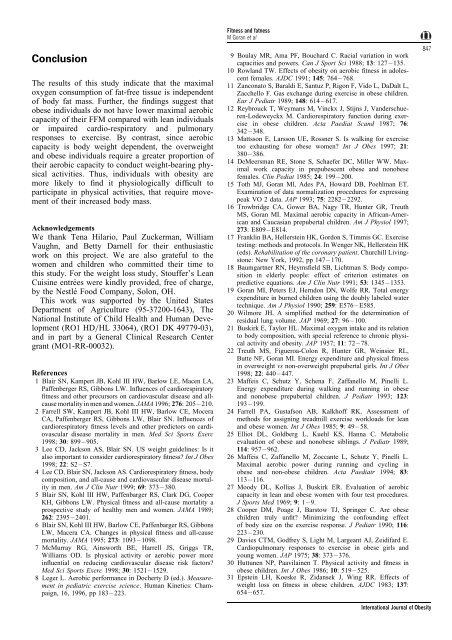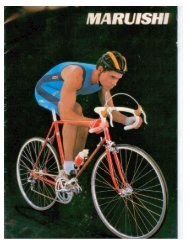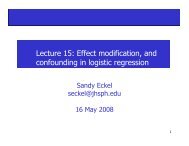Total body fat does not influence maximal aerobic capacity
Total body fat does not influence maximal aerobic capacity
Total body fat does not influence maximal aerobic capacity
You also want an ePaper? Increase the reach of your titles
YUMPU automatically turns print PDFs into web optimized ePapers that Google loves.
Conclusion<br />
The results of this study indicate that the <strong>maximal</strong><br />
oxygen consumption of <strong>fat</strong>-free tissue is independent<br />
of <strong>body</strong> <strong>fat</strong> mass. Further, the ®ndings suggest that<br />
obese individuals do <strong>not</strong> have lower <strong>maximal</strong> <strong>aerobic</strong><br />
<strong>capacity</strong> of their FFM compared with lean individuals<br />
or impaired cardio-respiratory and pulmonary<br />
responses to exercise. By contrast, since <strong>aerobic</strong><br />
<strong>capacity</strong> is <strong>body</strong> weight dependent, the overweight<br />
and obese individuals require a greater proportion of<br />
their <strong>aerobic</strong> <strong>capacity</strong> to conduct weight-bearing physical<br />
activities. Thus, individuals with obesity are<br />
more likely to ®nd it physiologically dif®cult to<br />
participate in physical activities, that require movement<br />
of their increased <strong>body</strong> mass.<br />
Acknowledgements<br />
We thank Tena Hilario, Paul Zuckerman, William<br />
Vaughn, and Betty Darnell for their enthusiastic<br />
work on this project. We are also grateful to the<br />
women and children who committed their time to<br />
this study. For the weight loss study, Stouffer's Lean<br />
Cuisine entreÂes were kindly provided, free of charge,<br />
by the Nestle Food Company, Solon, OH.<br />
This work was supported by the United States<br />
Department of Agriculture (95-37200-1643), The<br />
National Institute of Child Health and Human Development<br />
(RO1 HD=HL 33064), (RO1 DK 49779-03),<br />
and in part by a General Clinical Research Center<br />
grant (MO1-RR-00032).<br />
References<br />
1 Blair SN, Kampert JB, Kohl III HW, Barlow LE, Macen LA,<br />
Paffenberger RS, Gibbons LW. In¯uences of cardiorespiratory<br />
®tness and other precursors on cardiovascular disease and allcause<br />
mortality in men and women. JAMA 1996; 276: 205 ± 210.<br />
2 Farrell SW, Kampert JB, Kohl III HW, Barlow CE, Mocera<br />
CA, Paffenberger RS, Gibbons LW, Blair SN. In¯uences of<br />
cardiorespiratory ®tness levels and other predictors on cardiovascular<br />
disease mortality in men. Med Sci Sports Exerc<br />
1998; 30: 899 ± 905.<br />
3 Lee CD, Jackson AS, Blair SN. US weight guidelines: Is it<br />
also important to consider cardiorespiratory ®tness? Int J Obes<br />
1998; 22: S2 ± S7.<br />
4 Lee CD, Blair SN, Jackson AS. Cardiorespiratory ®tness, <strong>body</strong><br />
composition, and all-cause and cardiovascular disease mortality<br />
in men. Am J Clin Nutr 1999; 69: 373 ± 380.<br />
5 Blair SN, Kohl III HW, Paffenbarger RS, Clark DG, Cooper<br />
KH, Gibbons LW. Physical ®tness and all-cause mortality a<br />
prospective study of healthy men and women. JAMA 1989;<br />
262: 2395 ± 2401.<br />
6 Blair SN, Kohl III HW, Barlow CE, Paffenbarger RS, Gibbons<br />
LW, Macera CA. Changes in physical ®tness and all-cause<br />
mortality. JAMA 1995; 273: 1093 ± 1098.<br />
7 McMurray RG, Ainsworth BE, Harrell JS, Griggs TR,<br />
Williams OD. Is physical activity or <strong>aerobic</strong> power more<br />
in¯uential on reducing cardiovascular disease risk factors?<br />
Med Sci Sports Exerc 1998; 30: 1521 ± 1529.<br />
8 Leger L. Aerobic performance in Docherty D (ed.). Measurement<br />
in pediatric exercise science. Human Kinetics: Champaign,<br />
16, 1996, pp 183 ± 223.<br />
Fitness and <strong>fat</strong>ness<br />
M Goran et al<br />
9 Boulay MR, Ama PF, Bouchard C. Racial variation in work<br />
capacities and powers. Can J Sport Sci 1988; 13: 127 ± 135.<br />
10 Rowland TW. Effects of obesity on <strong>aerobic</strong> ®tness in adolescent<br />
females. AJDC 1991; 145: 764 ± 768.<br />
11 Zanconato S, Baraldi E, Santuz P, Rigon F, Vido L, DaDalt L,<br />
Zacchello F. Gas exchange during exercise in obese children.<br />
Eur J Pediatr 1989; 148: 614 ± 617.<br />
12 Reybrouck T, Weymans M, Vinckx J, Stijns J, Vanderschueren-Lodeweyckx<br />
M. Cardiorespiratory function during exercise<br />
in obese children. Acta Paediat Scand 1987; 76:<br />
342 ± 348.<br />
13 Mattsson E, Larsson UE, Rossner S. Is walking for exercise<br />
too exhausting for obese women? Int J Obes 1997; 21:<br />
380 ± 386.<br />
14 DeMeersman RE, Stone S, Schaefer DC, Miller WW. Maximal<br />
work <strong>capacity</strong> in prepubescent obese and nonobese<br />
females. Clin Pediat 1985; 24: 199 ± 200.<br />
15 Toth MJ, Goran Ml, Ades PA, Howard DB, Poehlman ET.<br />
Examination of data normalization procedures for expressing<br />
peak VO 2 data. JAP 1993; 75: 2282 ± 2292.<br />
16 Trowbridge CA, Gower BA, Nagy TR, Hunter GR, Treuth<br />
MS, Goran MI. Maximal <strong>aerobic</strong> <strong>capacity</strong> in African-American<br />
and Caucasian prepubertal children. Am J Physiol 1997;<br />
273: E809 ± E814.<br />
17 Franklin BA, Hellerstein HK, Gordon S, Timmis GC. Exercise<br />
testing: methods and protocols. In Wenger NK, Hellerstein HK<br />
(eds). Rehabilitation of the coronary patient. Churchill Livingstone:<br />
New York, 1992, pp 147 ± 170.<br />
18 Baumgartner RN, Heyms®eld SB, Lichtman S. Body composition<br />
in elderly people: effect of criterion estimates on<br />
predictive equations. Am J Clin Nutr 1991; 53: 1345 ± 1353.<br />
19 Goran MI, Peters EJ, Herndon DN, Wolfe RR. <strong>Total</strong> energy<br />
expenditure in burned children using the doubly labeled water<br />
technique. Am J Physiol 1990; 259: E576 ± E585.<br />
20 Wilmore JH. A simpli®ed method for the determination of<br />
residual lung volume. JAP 1969; 27: 96 ± 100.<br />
21 Buskirk E, Taylor HL. Maximal oxygen intake and its relation<br />
to <strong>body</strong> composition, with special reference to chronic physical<br />
activity and obesity. JAP 1957; 11: 72 ± 78.<br />
22 Treuth MS, Figueroa-Colon R, Hunter GR, Weinsier RL,<br />
Butte NF, Goran MI. Energy expenditure and physical ®tness<br />
in overweight vs non-overweight prepubertal girls. Int J Obes<br />
1998; 22: 440 ± 447.<br />
23 Maffeis C, Schutz Y, Schena F, Zaffanello M, Pinelli L.<br />
Energy expenditure during walking and running in obese<br />
and nonobese prepubertal children. J Pediatr 1993; 123:<br />
193 ± 199.<br />
24 Farrell PA, Gustafson AB, Kalkhoff RK. Assessment of<br />
methods for assigning treadmill exercise workloads for lean<br />
and obese women. Int J Obes 1985; 9: 49 ± 58.<br />
25 Elliot DL, Goldberg L, Kuehl KS, Hanna C. Metabolic<br />
evaluation of obese and nonobese siblings. J Pediatr 1989;<br />
114: 957 ± 962.<br />
26 Maffeis C, Zaffanello M, Zoccante L, Schutz Y, Pinelli L.<br />
Maximal <strong>aerobic</strong> power during running and cycling in<br />
obese and non-obese children. Acta Paediatr 1994; 83:<br />
113 ± 116.<br />
27 Moody DL, Kollias J, Buskirk ER. Evaluation of <strong>aerobic</strong><br />
<strong>capacity</strong> in lean and obese women with four test procedures.<br />
J Sports Med 1969; 9: 1±9.<br />
28 Cooper DM, Poage J, Barstow TJ, Springer C. Are obese<br />
children truly un®t? Minimizing the confounding effect<br />
of <strong>body</strong> size on the exercise response. J Pediatr 1990; 116:<br />
223 ± 230.<br />
29 Davies CTM, Godfrey S, Light M, Largeant AJ, Zeidifard E.<br />
Cardiopulmonary responses to exercise in obese girls and<br />
young women. JAP 1975; 38: 373 ± 376.<br />
30 Huttunen NP, Paavilainen T. Physical activity and ®tness in<br />
obese children. Int J Obes 1986; 10: 519 ± 525.<br />
31 Epstein LH, Koeske R, Zidansek J, Wing RR. Effects of<br />
weight loss on ®tness in obese children. AJDC 1983; 137:<br />
654 ± 657.<br />
847<br />
International Journal of Obesity




